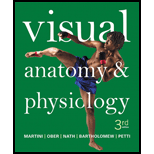
(A)
To describe: The components of the chemical synapse.
Introduction: The neurons are the basic fundamental units of the nervous system and also known as nerve cells. Just like all the cells in the human body, the neurons are also similar, but the key factor that separates the neurons from all the cells in the body is the neurons’ ability to transmit information among the neural cells.
(B)
To describe: The event that generates the action potential in the postsynaptic cell.
Introduction: The synapse is the communication between the two neurons. The synapse occurs by a presynaptic cell that contains the information to be conveyed and the postsynaptic cell that receives the information.
Want to see the full answer?
Check out a sample textbook solution
Chapter 11 Solutions
Visual Anatomy & Physiology Plus Mastering A&P withPearson eText -- Access Card Package (3rd Edition) (New A&P Titles by Ric Martini and Judi Nath)
- Neuronal pathway in Alzheimer’s disease and how it works . Draw a diagram .arrow_forwardExplain how the signal transmission at a synapse in an individual with Parkinson's disease is different than an unaffected individual. List the steps involved in an action potential moving from the axon terminal of the pre-synaptic neuron to the dendrites of the post-synaptic neuron. Explain how the process is different in individuals affected with Parkinson's disease.arrow_forwardGive the several types and classes of neurons, as well as their properties, functions, and similarities and differences.arrow_forward
- Describe common patterns of neuronal organization and processing.arrow_forwardDiscuss the activity, structures and chemicals of both the neural axon and receptor. And a discussion about the synapse should begin with a definition and a comparison of the two categories.arrow_forwardDescribe how neurotransmission occurs across a chemical synapse, using acetylcholine as an example.arrow_forward
- Explain why conduction at synapses is always one-way.arrow_forwardIdentify the four different types of neuronal pools, and explain how they function.arrow_forwarda. describe the effect on the behavior of a neuron affected by hyperkalemia b. If muscles are attached to the neuron in question, what is the effect on that muscle- flaccid or tonic paralysis? (For example, hyperkalemia has a drastic effect on the heart muscle. What would that effect be?)arrow_forward
- . “Facilitation in a neuronal pool” refers to .arrow_forwardState the function and location of axon.arrow_forwardstarting with an axon that is maintaining a resting potential, describe the sequence of events that causes the generation of an action potential, including the electrical charges and ions involved.arrow_forward
 Human Biology (MindTap Course List)BiologyISBN:9781305112100Author:Cecie Starr, Beverly McMillanPublisher:Cengage Learning
Human Biology (MindTap Course List)BiologyISBN:9781305112100Author:Cecie Starr, Beverly McMillanPublisher:Cengage Learning Human Physiology: From Cells to Systems (MindTap ...BiologyISBN:9781285866932Author:Lauralee SherwoodPublisher:Cengage Learning
Human Physiology: From Cells to Systems (MindTap ...BiologyISBN:9781285866932Author:Lauralee SherwoodPublisher:Cengage Learning

